Skydive & Rowlf Tickles The Ivories
Saturday, January 24, 2009

There is nothing more fun than a pleasant night at the theatre. Sometimes it can be a tad out of the conventional. When you attend an opening performance of just about any show at the Arts Club Theatre, Granville Island Stage as we did last night (Skydive) you can expect John Hall to be playing the piano at the end of the stairs by the upstairs bar. Hall has been playing the piano for 40 years and I asked him if he was paid for doing so last night, "I sure hope so," he answered. Hall plays many jazz styles ("I don't do stride.") and seems to specialize in a mean boogie-woogie with a penchant for injecting snippets of Paul Desmond's Take Five into Christmas carols as he did back in December for It's A Wonderful Life. Hall plays low and his arms go wide. He nods his head to the side in enthusiasm and is a spitting image of Rowlf the resident pianist of the Muppet Show.
We sit down at our seats ready for a two or thre act play with a pleasant intermission. Not this time. We are repeatedly told there is no intermission. Hidden in the message is a, "And you better go to the bathroom now while you can."

The music before the curtain opens is usually a pleasant harbinger of things to come. Last night it was impossibly loud heavy metal. I commented to my wife, "I am going to go crazy if this persists." It did but in the context of the play it worked.
The show opened in a most unexpected way (I really recommend to skip the program as it reveals stuff that is better that your find out on your own. The dynamite revelation at the end of the show is best left as a surprise!)
I could write about those four dark dressed guys (they look like US Navy Seals ready to sink a battleship) whose performance with the aerial devices is sheer virtuosity and how a simple mistake on their part could be "crash and burn" for actors Bob Frazer and James Sanders. There is something there to the fact that Bob Frazier (playing younger brother Daniel) never touches ground while James Sanders (plays older brother Morgan) does eventually does. I will not reveal the how here. Again, I repeat, don't read the program.
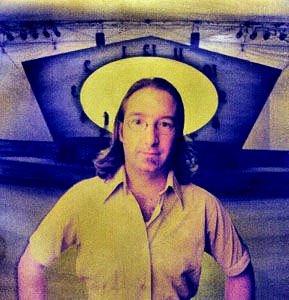
I wonder not about the dreams that these two brothers have and how they even manage to share one simultaneously. I wonder about playwright Kevin Kerr's dreams. I did so last night and came to the conclusion that Director Roy Surette, above, right, (with co-direction help from Stephen Drover) set designer Yvan Morissette, below left( Was he responsible for those tiny little guys that moved like real people?) and Kevin Kerr top, left, were kidnapped by aliens and while up there in the flying saucer they dreamt this wonderful play that in the end was lifted not by the special effects, but by my extreme jealousy of never having experienced the delight of having a brother. The warmth of the brother's relationship and of John Hall's exuberant piano playing before the performance made me smile. I went home content after another fine evening at the theatre, even if it was not in the least conventional or expected.
Skydive is a Realwheels production presented by the Arts Club Theatre Company and the PuSh International Performing Art Festival. Skydive ends February 7.
The Duthie Reader - Alive & Well In Cyberspace
Friday, January 23, 2009

For 20 years beginning in 1980 Duthie Books and Celia Duthie (below, right) published in Vancouver a little gem four times a year called The Reader. Celia Duthie would ask some of her friends and, some who were not, to review books for it. She had one command, a command she gave me once and which I always followed to the letter, "Try and pick a book you think you are going to like."
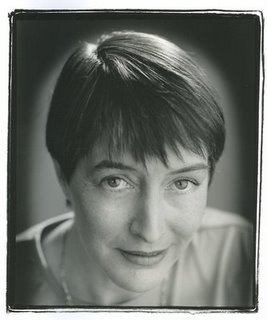
The whole idea for today's blog suddenly came to me last night when I read the following in Edmund Wilson's Memoirs of Hecate County, in the story The Millhollands And Their Damned Soul :
"We wondered whether you mightn't like to do a piece about the book in the Christmas number of the Booklover - I thought it would be right up your alley."
But this book by George Paine was the first that I ever refused to review for the Mullhollands. I realized that there would now be conditions imposed which I had not had to worry about in writing for the Booklover before, in the pre-Reader's Circle days: I should have to say the book was good and I should have to make it sound important.
I never had the problem the narrator of that story had. I reviewed quite a few books for Celia Duthie and I always picked books I was excited about. My editor at The Reader was Maja Grip, perhaps the most retentive editor I have ever met yet who gave me the freedom to have fun in my reviews. Even though the magazine is long gone most of the reviews live on in the archives of The National Library of Canada Electronic Collection. My favourite of all my reviews is a double one I made which included books by Mario Vargas Llosa and Paco Ignacio Taibo II. The original article did include the photo of Mario Vargas Llosa that is here. I am including a photograph that I took of Paco Ignacio Taibo II in the two-block long Chinatown in Mexico City.
The Reader XIV II - A Fish In The Water & Four Hands
--------------------------------------------------------------------------------
A Fish In The Water
By Mario Vargas Llosa
Translated by Helen Lane.
Farrar Straus Giroux, New York, 1994, 532 pp., $32.95
Four Hands
By Paco Ignacio Taibo II
Translated by Laura C. Dail.
St. Martin's Press, New York, 1994, 378 pp., $31.99
Reviewed by Alex Waterhouse-Hayward
If you were to approach a Hollywood producer with a screenplay based on a true story in which a Peruvian writer marries, as a minor, an older aunt; writes about it in a novel ( Aunt Julia and the Scriptwriter), that is made into a movie (Tune in Tomorrow, 1990) with a screenplay by a highly regarded Ghanian author (William Boyd) who changes Lima to New Orleans, you would probably be ejected before you could proceed to add that the novelist subsequently dumps his aunt in Paris for his first cousin whom he marries. At the Mexico City premiere of a movie based on his novel Captain Pantoja and the Special Service, he punches and floors a Colombian Nobel Laureate (Gabriel García Márquez). He writes many acclaimed novels until as a restless 50-year-old he ponders the possibility of writing a comedy about an impresario who finds a childhood friend whom he thought was dead, alive, well and now a woman in a suite at the Savoy in London. The project is shelved in favour of running for President of Peru, a job he almost wins but for the fact that he eats a not-so-fresh ceviche in Piura and discounts, until too late, the competition from a Protestant Japanese/Peruvian agronomist dubbed the chinito (the little Chinaman).
In A Fish in the Water Vargas Llosa tells his story from his birth in Arequipa until age 22 while deftly alternating with a fascinating blow-by-blow account of his 1987 to 1990 unsuccessful run for the Peruvian presidency. "It is true that if the presidency of Peru had not been the most dangerous job in the world, I jokingly told a journalist, I would have never been a candidate." On a lonely Piura beach in August 1987 Vargas Llosa ponders the historic inability of Peru to improve itself: "That historical failure seemed to me to be a sort of sign of a country which, at some moment in its trajectory, fucked itself all up."
You wouldn't fare any better with the Hollywood producer if you were to return with a different story about a Mexican/Spanish writer (Paco Ignacio Taibo II) who writes acclaimed thrillers ( An Easy Thing, Some Clouds, No Happy Ending), whose hero, Héctor Belascoarán Shayne, is a jazz-loving Chinese food enthusiast Mexican/Basque/ Irish private dick in Mexico City, who singlehandedly manages to escape from the clutches of corrupt judiciales, or the equally corrupt government officials of the Partido Revolucionario Institucional. Realizing you are not getting anywhere you explain that Taibo has now written something completely different. In Four Hands, Arthur Stanley Jefferson (known after 1920 as Stan Laurel) witnesses, while on a binge with 9 bottles of Bols gin, Pancho Villa's assassination in Parral, Chihuahua. Stoyan Vasilev, an 80-year-old veteran of the Spanish Civil War, is an unwitting pawn of a complicated anti-Sandinista plot. The plot is thwarted by Longoria, a twice-dead Spaniard buddy of Vasilev's who lives in the Sanatorio Español on Avenida Ejército Nacional in Mexico City. The interlacing plot includes Leon Trotsky, writing a thriller while working on his Stalin biography, and two journalists (who work together---hence the four hands), one Mexican and fat, Julio (who is obsessed with Laurel & Hardy films); the other Jewish American and thin, Greg, whose uncle was Houdini's psychiatrist).

To those readers who are used to the linear approach of most contemporary fiction, Four Hands can serve as an exciting initiation into the more complex but in the end very satisfying style of novels such as Llosa's Conversation in the Cathedral or to what may have been the first example of early hypertext, Julio Cortázar's Hopscotch. That might then lead to the discovery of such Latin American writers as Augusto Roa Bastos, Alejo Carpentier, or Gabriel García Márquez.
Somehow the Hollywood producer is convinced and the green light is given on the above projects so I decide to cash in on my own personal experiences. This reviewer used to play ping pong in the early 60s in the premises of the Club Mundet. This is an athletic club in Mexico City on Avenida Ejercito Nacional, not far from the Spanish Hospital, whose members were mostly exiled Spanish Republicans. One of the better challenges was playing against a very short spectacled kid called Paco. He was so short that I could barely see his eyes over the edge of the table. He was interested in my interest in photography and wanted me to accompany him to photograph the one block-long Chinatown on Dolores Street.
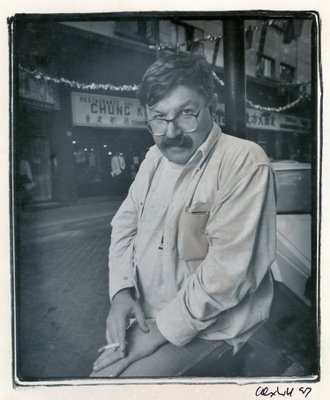
In 1990 I went to Lima to ask Mario Vargas Llosa why it is that he obsessively describes red geraniums growing in the front gardens of the houses in many of his Lima novels. His answer was, "Vasco da Gama returning from the Cape of Good Hope took the geranium back to Portugal. From there it was taken to Extremadura in Spain where it thrived in the desert environment. The Conquistadores Cortez and Pizarro brought the plant to America. In Lima nothing grows except the geranium. It should be our national flower as it thrives in adversity." Vargas Llosa was not feeling well (see photo) so he did not attend a campaign talk at the Peruvian/Japanese Society. The members did not believe the story of the not-so-fresh ceviche he had eaten in Piura. Because of his sickness his campaign manager decided to make some TV spots in Llosa's back garden in Barranco. It was soon transformed to look like a pueblo joven (slum). An appropriately "dirtied" little boy was brought in to pose.
As Belascoaran Shayne asks in Sueños de Frontera, 1990, in a Taibo tribute to Vargas Llosa, "A qué horas se jodió todo? When did it fuck itself all up?"
I know.
Alex Waterhouse-Hayward is a Vancouver photographer of Latin American Ancestry.
--------------------------------------------------------------------------------
{ Literascape } { What's New } { The Reader } { Fall 1994 }
Copyright © 1996 Duthie Books Ltd. All Rights Reserved. Literascape is a Trademark of Duthie Books, Ltd.
Here for a delightful review of a Patrick O'Brian novel by Marv Newland.
The Reader was a lovely little booklet/magazine printed in very good stock. It was a little jewel full of passionate reviews by reviewers who loved to read and picked books by their favourite authors or authors that wrote about something that they, too had a passion for. Witness the above loving review of O'Brian's novel by a nautically obsessed Marv Newland. This sort of review does not appear, to my knowledge, in any other Vancouver publication. At one time even the Vancouver Sun occasionally paralleled The Reader. I can remember the day day sometime in 1998 when I received a phone call from then Arts Editor, Max Wyman, who said, "Alex, I have here A History Of The Breast by Marilyn Yalom. I think this would be right up your alley. Would you want to review it?" Of course I was interested and, yes, I did review it. Max Wyman, Celia Duthie were are you?
Free Will & Wreck Beach
Thursday, January 22, 2009
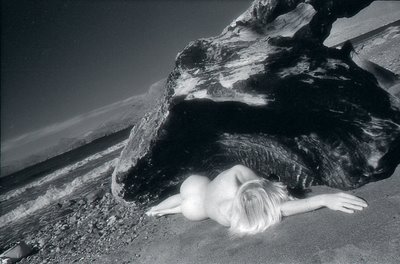 My wife Rosemary and I differ in how we look at our past. Rosemary spends long hours, as I sleep, wondering about the what ifs and the what if I had nots.
At our religion class at St. Ed's in Austin Texas we often liked to detour Brother Edwin Reggio CSC from the topic at hand. One of our favourites was to bait him with the concept of free will. "How is it possible for there to be free will if God is All Knowing?" we would ask him. To this day I have a deep respect for this adroit man who gave us logical answers and never got angry at us except twice.
Once it involved one of the biggest and heaviest of us, Byron Todd and the other and obstreperous Richard Mosby who was the only black student in our class. Both talked out of turn and pressed some buttons that we did not know Brother Edwin had. Brother Edwin, 5ft 1 was short and a tad compact. He picked Mosby on the one day and Todd on the other (some of my classmates swear it happened on one day and that he picked up each boy at the same time) with one arm and threw him across the room. We were impressed beyond imagination wondering what laws of physics our Brother Edwin had circumvented. It was only last year that Brother Edwin told me that his father and he and his brother had been Olympic ring champions.
My belief is that Brother Edwin welcomed our break-the-topic-of-the-day detour because he liked to debate and make us use our brains. He never gave us a hint at all the he knew what we were up to.
On the day that we asked him about free will he explained it like this:
Picture yourself up on the top of a mountain and you are looking down on both sides of a sharp hairpin curve. You see cars coming, very fast from either direction and you can also spot a large rock impeding one lane where the curve is at its sharpest. You can see that the cars will be involved in a head on collision. Perhaps you could stop the accident but you choose not to. That's free will.
I sleep most nights well while Rosemary agonizes on how we could have better invested our money or obtained better jobs or purchased a better house for less money (and bathrooms that don't leak) and in the right side of Granville instead of the wrong one. She wonders where we went wrong because our daughters didn't marry lawyers or engineers.
When we first came to Vancouver in 1975 I was not able to get work as a photograpaher. I was simply not as good as I thought I was. I needed experience and knowledge of what was available in town. I ended up washing and renting cars for Tilden-Rent-A-Car (In Canada It's Tilden. May I help you?) The shift work meant that I only had one complete weekend per month. There were days when the girls were in school and Rosemary was at work.
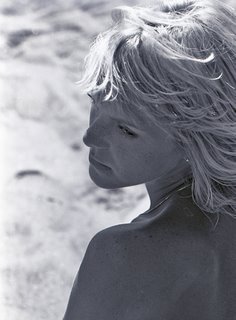
I would go to lie on the sand of Wreck Beach in the Summer. I ran into people who had ways of only working in spring and fall so that they could travel in winter and lie on the beach in the summer. I was jealous even though many worked as waiters or waitresses and in the construction business. These were jobs I was not keen to look for. To this day Rosemary insists I was a lazy bum for many years and that I should have found better things to do with those spare days. "You could have looked for a better job."
What is the connection of the above with the pictures of a blonde school teacher called Marli W that I met at Wreck Beach? It was at Wreck Beach that I honed my photography of the human form. It was my on the spot live art class. I tried new films, odd films, odd film/developer combinations and in a couple of the pictures here I perfected my understanding of Kodak b+w Infrared Film and Kodak Special Order SO-115 which had incredibly fine grain and a shift towards the red that rendered skin luminous. I practiced using extreme wide-angles and learned how much distortion was acceptable. I learned to photograph the human form as pure form. It was later, as a I developed more confidence, that I started shifting towards the portrait.
 Marli W. was a lovely and patient young woman who posed for me for long hours without protest and made me feel that what I was doing was the right thing and that it would better me. And best of all she taught me to appreciate poise and elegance.
No if I could only convince Rosemary. She would sleep nights.
St Edward's High School
No Streaming Video Of Abraham Lincoln In My Head
Wednesday, January 21, 2009

Yesterday my wife lept from the 20th to the 21st century in bed. She watched Obama's swearing in ceremony as streaming video on the NY Times with her Toshiba laptop. I did my best to read the hard copy version of the paper while juggling a large mug of strong tea. Last night after she returned from a computer class she immediately turned on the TV to see what Michelle Obama's ball gown looked like.
I had this curious feeling that I did not want to listen to Obama make yet one more speech. Yet there I was as he made one, so out of context, between dances while his wife behind him was waving acknowledgment to friends. It seems this guy could even give a speech while barbecuing.
Ubiquity of Obama's face and voice has done me in. I gave it some thought last night and came to the realization that Abraham Lincoln and even Ulysses Simpson Grant seem to be so much more real in the b+w images that I have in my mind of them as oposed to all those streaming colour videos of Barack Obama. Ubiquity is making him invisible to me. Or at the very least when he turns his face to one side while speaking (which projects seriousness and the weight of pathos) I feel I am watching a Bugs Bunny cartoon. This is not in any way a feeling of disrespect. Much to the contrary I hold much hope that finally we (as in the world) have an intellectual in the White House who is known for reading books. As my Canadian Tire flyers point out, "Now, that's different!"
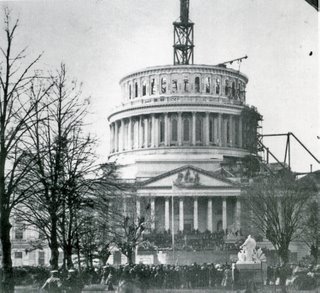
My reaction to streaming colour is perhaps the effect of that special moment in my life when I was around 8 when I went to an American library in Buenos Aires and gazed on my first photographs of American Civil War soldiers taken by Matthew Brady, Timothy O'Sullivan and Alexander Gardner. The sharp and stark b+w images made the man I stared at look like their pictures had been taken days or hours before. Then it sank in (my first intimation of my own mortality) that these men had been dead for almost a century. These were the first photographs of real people that I really ever seen. That impression has remained to this day.
Photographer Alexander Gardner took that glass plate portrait of Lincoln with the crack (ominous in retrospect) on February 5, 1865 less than two months before his assassination. The portrait of Grant, it has a startling modern look to it, I found, with no credit and undated in my book My Brother's Face - Portraits of the Civil War In Photographs, Diaries and Letters by Charles Phillips and Alan Axelrod, Chronicle Books San Francisco, 1993.
What is even more startling and endearing, too, is what Grant wrote of his meeting with Lee to accept his formal surrender at Appomattox:
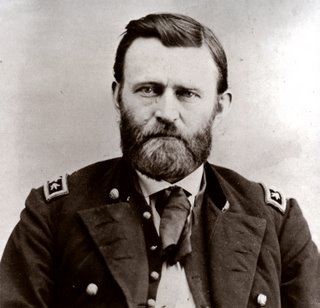 When I went into the house I found General Lee. We greeted each other, and after shaking hands took our seats. I had my staff with me, a good portion of whom were in the room during the whole of the interview.
When I went into the house I found General Lee. We greeted each other, and after shaking hands took our seats. I had my staff with me, a good portion of whom were in the room during the whole of the interview.
What General Lee's feelings were I do not know. As he was a man of much dignity, with an impassible face...his feelings... were entirely concealed from my observation; but my own feelings...were sad and depressed. I felt like anything rather than rejoicing at the downfall of a foe who had fought so long and valiantly and had suffered so much...
General Lee was dressed in full uniform which was entirely new, and was wearing a sword of considerable value...In my rough traveling suit...I must have contrasted very strangely with a man so handsomely dressed, six feet high and of faultless form...
We soon fell into conversation about old army times... Our conversation grew so pleasant that I almost forgot the object of our meeting.
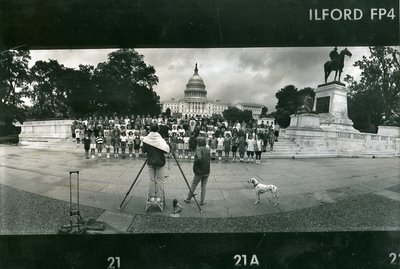
In one of my many visits to Washington DC, this one in the 1990s I happened on a scene where a photographer was using an old Cirkut 5x7 inch swivel lens panoramic camera to photograph a group. The photographer, James E Ivey had inherited the exclusive franchise and the camera from his father. At the time Ivey was there almost every day of the week with his Dalmation. On the far right the man on the equestrian statue is Ullyses S. Grant. It was June and when I walked up the capitol steps I could smell the fragrance coming from a huge Magnolia grandiflora or Southern Magnolia and I wondered if Abraham Lincoln had ever stopped to smell them, too.
The picture above of Lincoln's inauguration was taken March 4, 1861 by Montgomery C. Meigs. This year I plan to find, buy and read The Personal Memoirs of Ulysses S. Grant.
Rebecca At The Willard Hotel
 In 2003 Rosemary, Rebecca and I visited Washington DC. I insisted in having lunch at the venerable Willard Hotel. I explained to Rosemary and Rebecca that the term lobying came from the early meetings in the 1850s, 60s and 70s of politicians with people who wanted to "buy" favours. Surely Abraham Lincoln and others must have walked the corridors of the hotel. I thought I could feel their presence. Some day Rebecca will return to DC. If she happens to lunch at the Willard Hotel I hope she still remembers and runs into my presence.  We walked to the Capitol and I showed Rebecca and Rosemary the large Magnolia grandiflora on one side of the capitol steps. I told her that Abraham Lincoln might have stopped to smell the very large and beautiful white flowers. At the National Gallery Rebecca spotted this painting ( Giant Magnolias on a Blue Velvet Cloth, Martin Johnson Heade) and said, "Look that could even be Abraham Licoln's magnolia."
Doña Marina, Tiny Bananas, Pineapple Juice & Turkey Tacos
Tuesday, January 20, 2009
Bernal Díaz del Castillo in his Historia Verdadera de la Conquista de La Nueva España mentions the appearance of La Malinche (as Mexicans call her and Doña Marina as Spaniards reverently call her) in April of 1519, when she was among twenty slave women given by the Chontal Maya of Potonchan in the present-day state of Tabasco to the triumphant Spaniards. According to Díaz, Malinche was the noble first-born child of the lord of Paynala near present-day Coatzacoalcos, then a "frontier" region between the Aztec Empire and the Maya states of the Yucatán Peninsula. In her youth, her father died and her mother remarried and bore a son. Now an inconvenient stepchild, the girl was sold or given to Maya slave-traders from Xicalango, a commercial town further south and east along the coast. Díaz claims Malinche's family faked her death by telling the townspeople that a recently deceased child of a slave was Malinche. At some point, she was given or sold again, and was taken to Potonchan, where she was ultimately given to the Spaniards.
Since la Malinche was fairly attractive Cortés gave her to noble born friend Alonzo Hernando Puertocarrero. When Cortés sent Puetocarrero as an emissary to the court of Holy Roman Emperor Charles V (but also Charles I King of Spain) he kept her for himself. Her knowledge of the lingua franca of the region Nahua meant that when she learned Spanish she was able to translate for Cortés.
To this day Mexicans have a complex relationship with a woman they feel sold them out to the Spaniards. There are some, who to the contrary, think that as she was also the lover to Cortés, she was able to somewhat soften the effect of the Spanish conquest. The language and customs survived to the present day. The Aztecs noted such a closeness between La Malinche and Cortés that they called them both by the epithet Malintzin. In the Mexico of today a malinchista is a person who prefers the foreign to the domestic. La Malinche fades into history in 1529 and or 1551, both dates given as her possible death.
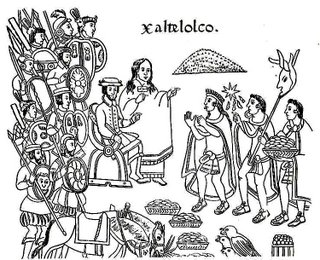
When my mother returned from a trip to Mexico in 1953 (we moved to Mexico from Argentina the next year) she told me how there was not a single statue, memorial, street, park named after Hernán Cortés. The exception to the rule was a hotel of somewhat ill-repute (refurbished in the 70s) near the centre of the city called el Hotel Cortés.
The father of one of my favourite Mexican/Spanish writers, Paco Ignacio Taibo II, Paco Ignacio Taibo I tells a story in a lovely CD I bought many years ago in Mexico about leaving Franco's Spain in 1958. Paco senior, like his son, were both of severe leftist tendencies. There was no room for the father and his family in dictatorial Spain. They sailed for Mexico. In a delightful bit of magic realism, Paco Ignacio Taibo I decides to invite a little old lady who also lived forgotten in Spain. The little old lady is Doña Marina as Spaniards reverently call La Malinche. Doña Marina reluctantly accepts but becomes very depressed saying that Mexicans will reject her when they arrive at the port city of Veracruz. She locks herself in her cabin. Taibo I brings her jugo de piña (pineapple juice), plátanos dominicos (finger bananas) and feeds her tacos de guajolote (turkey tacos). When the ship finally arrives and Doña Marina finally emerges from her cabin she is young again and beautifully dressed in white. Taibo I tells Doña Marina, "Let's disembark and enter your land again. Both of us are from conquered people (Taibo’s leftists leanings defeated by Franco), we have that to share." Doña Marina replies, "I will try again."
When they disembark and go through customs they feel the presence of a middle-aged man dressed in a suit of armor. Taibo I and Doña Marina note it is Hernán Cortés. They are surprised to find him alive and in Veracruz since those who know, know his remains are walled in the church of San Juan de Diós in Mexico city a few meters from the old Cortés Hotel. Cortés looks at the pair and says, "Otro gachupín nos cae encima, “or "Another Spaniard is upon us to bring us tragedy." Cortés turns around and loudly shuffles away in his rusty armor.
To this day I often look at Mexicans in the street, Mexicans in buses, Mexicans at the beach, Mexicans everywhere, and in spite of North Americans from the US and Canada asserting that Mexicans are a happy "fiesta" people I can always discern a look of sadness and tragedy in their faces. I saw this when I was attempting to photograph the lovely Ms Hernandez as an Aztec princess. The more I look at my picture the more I think that the Aztec princess in question is none other than Doña Marina. She is a Doña Marina that, alas, Paco Ignacio Taibo cannot feed turkey tacos, pineapple juice and finger bananas. Taibo I died in Mexico, his adopted land, last year.
It might interest some that the Spanish name for a finger bananas, dominicos also means a Dominican priest or monk. There are those who further add that the size of the little bananas reflects a specific organ of the hated priests who were in charge of the Spanish Inquisition. Furthermore in most Spanish speaking countries a bakery delicacy there is a largish spherical concoction almost identical to a donut hole. Mexicans and Spaniards like to dunk them in thick hot chocolate. Depending on whom you ask this delightful pastry is either called suspiros de monja (a nun's sigh) or bolas de monje (a monk's testicles). And the inhabitants of the Dominican Republic, distancing themselves from any connections to priests and finger bananas, call themselves dominicanos.
La Mujer Durmiente - The Sleeping Woman
Monday, January 19, 2009
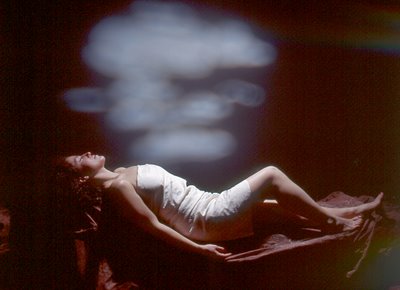 In 1952 my mother made an exploratory trip to Mexico from Buenos Aires. While there she had her hand read by a curandera woman who told her that her attraction to two volcanoes of the Valley of Mexico, Popocatepetl and Ixtacciuatl would make her return. When we did move in 1954 my mother pointed out the two snow-capped mountains from the window of our PanAm plane. I had never seen real snow except in films. Our airplane had crossed the Andes from Buenos Aires to Chile at night on our way to Mexico. Because our airplane was an early version of the Douglas DC-6B it wasn't properly pressurised and we were given oxygen masks when we crossed the darkened peaks of the Andes. From then on whenever I could spot the two volcanoes I would gaze in wonder. By the late 60s Mexico City's pollution hid them except for a few days of the year. There are many Aztec legends about the two peaks. Ixtacciuatl was the sleeping maiden who waited in vain for her Aztec warrior to return from war. When he returned he found her asleep. The story ends much like an opera. In Spanish Ixtacciuatl is called la mujer durmiente or the sleeping woman. 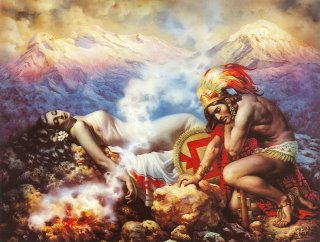 It is surprising how the most obvious of things isn't always so. It hit me some years ago (not that long!) that nostalgia could only be felt outside of the place you had the feeling for. Thus after a year of living in Venice (if that were ever to happen to me) I would be suffering from Vancouver nostalgia and I would be out scouring the canals in the lookout for an attractive Canadian woman I could photograph undraped under an umbrella. Since I met the lovely Ms Hernandez who hails from León, Guanajuato some months ago I have been taking her pictures and imposing (she is most willing) my nostalgia on her. Today's which is a photograph I took yesterday, is my nostalgia for those Mexican volcanoes of my youth. 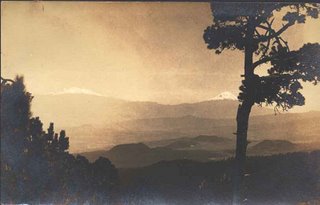 In the late 60s I spent 2 months working as un unpaid assistant to the then most famous Mexican commercial photographer, Arno Brehme. His father Hugo Brehme had become famous in the 20s taking pictures of artistic Mexico which were subsequently converted into postcards. One of his most famous is of the two volcanoes.
The Princess With The Golden Hair
Sunday, January 18, 2009
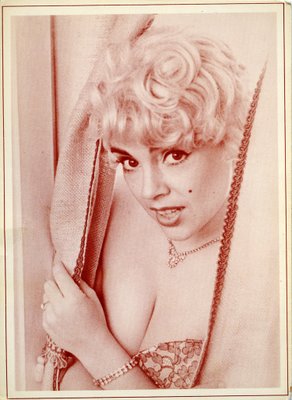 I got to like the big-hipped cat-faced women of the photographs shown as lures out in the front of the Fourteenth Street burlesque show; the announcements of moving picture palaces bejeweled with plastic-bright lights; the little music shops that sold big brass-band instruments and Slavic and Balkan records and had radios tht blared into the street; the Field's restaurant window with the white-aproned girl, blue-livid under a mercury tube, making pancakes on a hot metal slab; the young women of the pavements, some of them pretty, Italian or Jewish or whatever, stopping to look in at the displays in the windows of the dress and the shoe shops.
I got to like the big-hipped cat-faced women of the photographs shown as lures out in the front of the Fourteenth Street burlesque show; the announcements of moving picture palaces bejeweled with plastic-bright lights; the little music shops that sold big brass-band instruments and Slavic and Balkan records and had radios tht blared into the street; the Field's restaurant window with the white-aproned girl, blue-livid under a mercury tube, making pancakes on a hot metal slab; the young women of the pavements, some of them pretty, Italian or Jewish or whatever, stopping to look in at the displays in the windows of the dress and the shoe shops.
The Princess with the Golden Hair - Memoirs of Hecate County - Edmund Wilson

It was sometime in 1981 that I was approached by the very lovely but also very politically active Anne Gordon. She had helped organize the Vancouver strippers into an organization called VEDA (Vancouver Exotic Dancers Association).They organized stripathons for charity. What Gordon wanted from me was a series of risque postcards that were going to be sold at something called The Best Of Burlesque 1981 that was going to be held at the Marr Hotel on Powell Street.
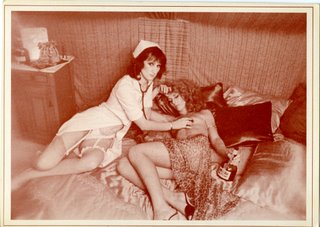
I took 9 different situations and I am posting 7 of them here as the other two would be completely defaced of any value if I were to hide "stuff." By today's standards these postcards are tame indeed but perhaps some of you might discern just a bit of charm.
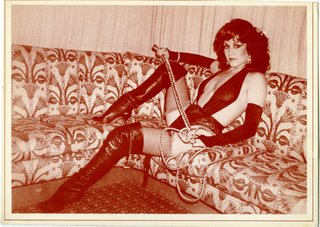
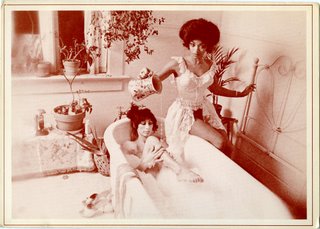 
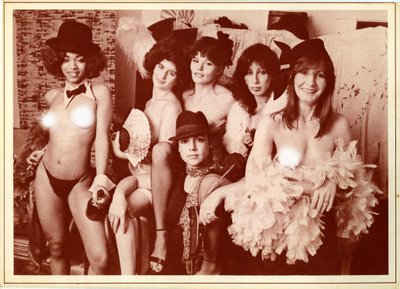
|


































